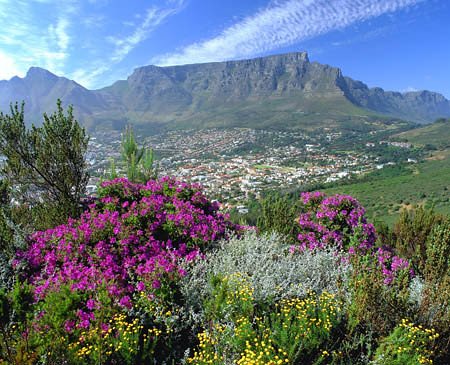Imagine standing on top of a mountain that’s older than the Amazon rainforest, gazing down at a world that evolution forgot to update. Table Mountain in South Africa isn’t just a stunning backdrop for Cape Town – it’s a living laboratory where time seems to have stopped, trapping creatures in evolutionary amber for millions of years. This ancient sandstone giant has been quietly nurturing some of the planet’s most bizarre and forgotten species, creating a biological treasure chest that scientists are only beginning to unlock.
The Ancient Fortress That Time Forgot

Table Mountain stands like a weathered sentinel, its flat summit rising 1,085 meters above sea level, crowned by layers of sandstone that formed roughly 500 million years ago. This isn’t just any old mountain – it’s essentially a biological island floating in the sky, cut off from the surrounding landscape by sheer cliffs and dramatically different climates.
The mountain’s unique geological structure created what biologists call “sky islands” – isolated pockets of habitat that became evolutionary laboratories. When sea levels rose and fell over millions of years, and when climates shifted from tropical to temperate, Table Mountain remained relatively stable, providing refuge for species that couldn’t adapt quickly enough to survive elsewhere.
When Isolation Becomes Evolution’s Playground

Isolation does strange things to evolution. Cut off from their mainland relatives, the species on Table Mountain began following their own evolutionary paths, like jazz musicians improvising solo riffs that gradually became entirely new songs. This process, called adaptive radiation, has been happening here for millions of years.
The mountain’s diverse microclimates – from bone-dry rocky outcrops to misty forest pockets – created multiple evolutionary pressures within a relatively small area. Species didn’t just survive; they specialized, adapted, and eventually became so unique that they exist nowhere else on Earth. Some estimates suggest that over 70% of the plant species found on Table Mountain are endemic, meaning they’ve evolved specifically for this mountain and call nowhere else home.
The Fynbos Kingdom of Botanical Misfits
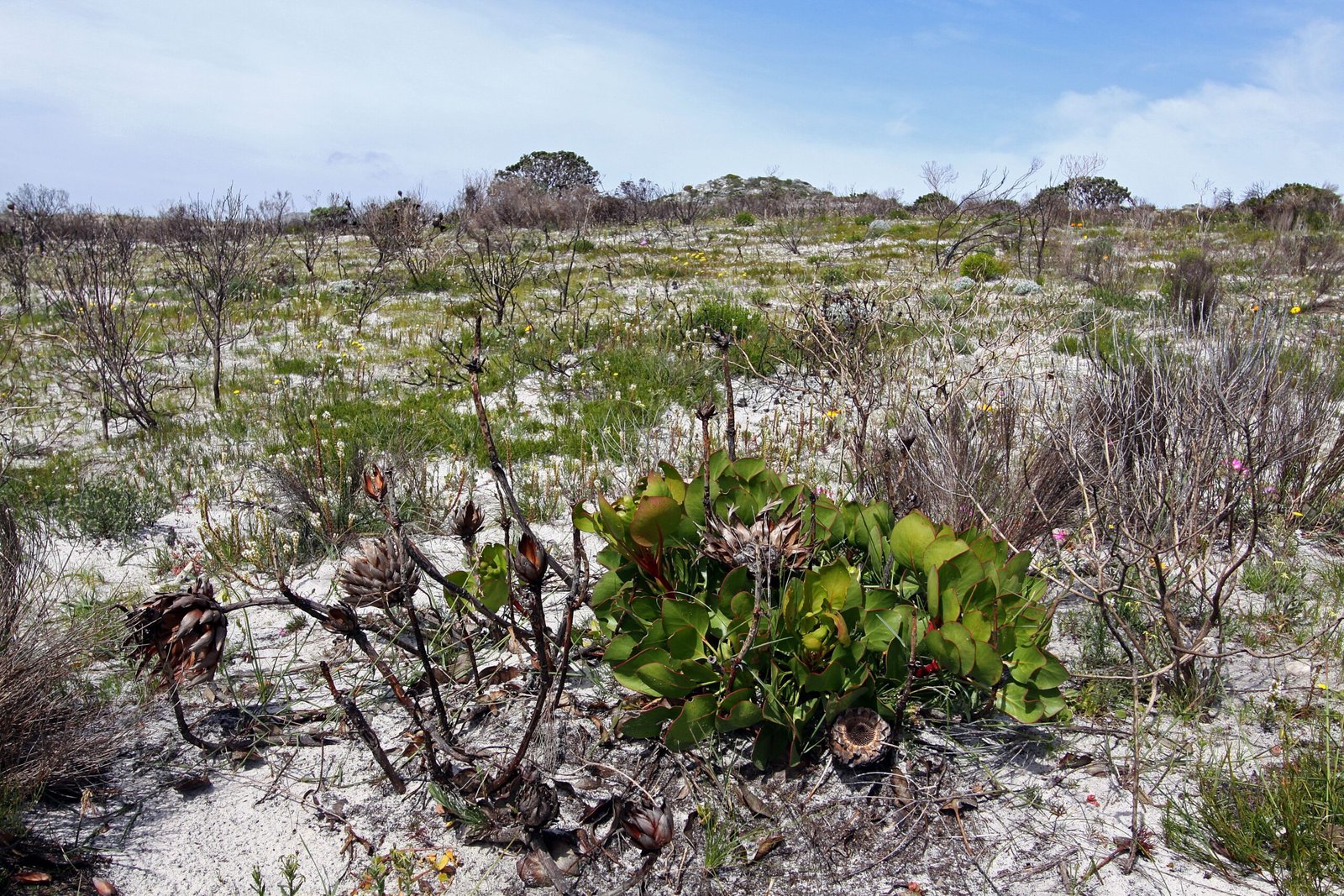
The mountain’s most famous residents aren’t animals at all – they’re plants that belong to the fynbos biome, one of the world’s six floral kingdoms despite covering less than 4% of southern Africa’s land area. This isn’t your typical mountain vegetation; it’s more like nature’s punk rock phase, full of spiky, silver-leafed rebels that thumb their noses at conventional botany.
Among these botanical oddities are the proteas, South Africa’s national flower, which have evolved into dozens of species that look like they were designed by an alien artist. Some proteas have learned to survive fires by storing their seeds in specialized cones that only open after intense heat, while others have developed relationships with specific birds and insects that exist nowhere else on the planet.
Dassies: The Mountain’s Unlikely Elephants
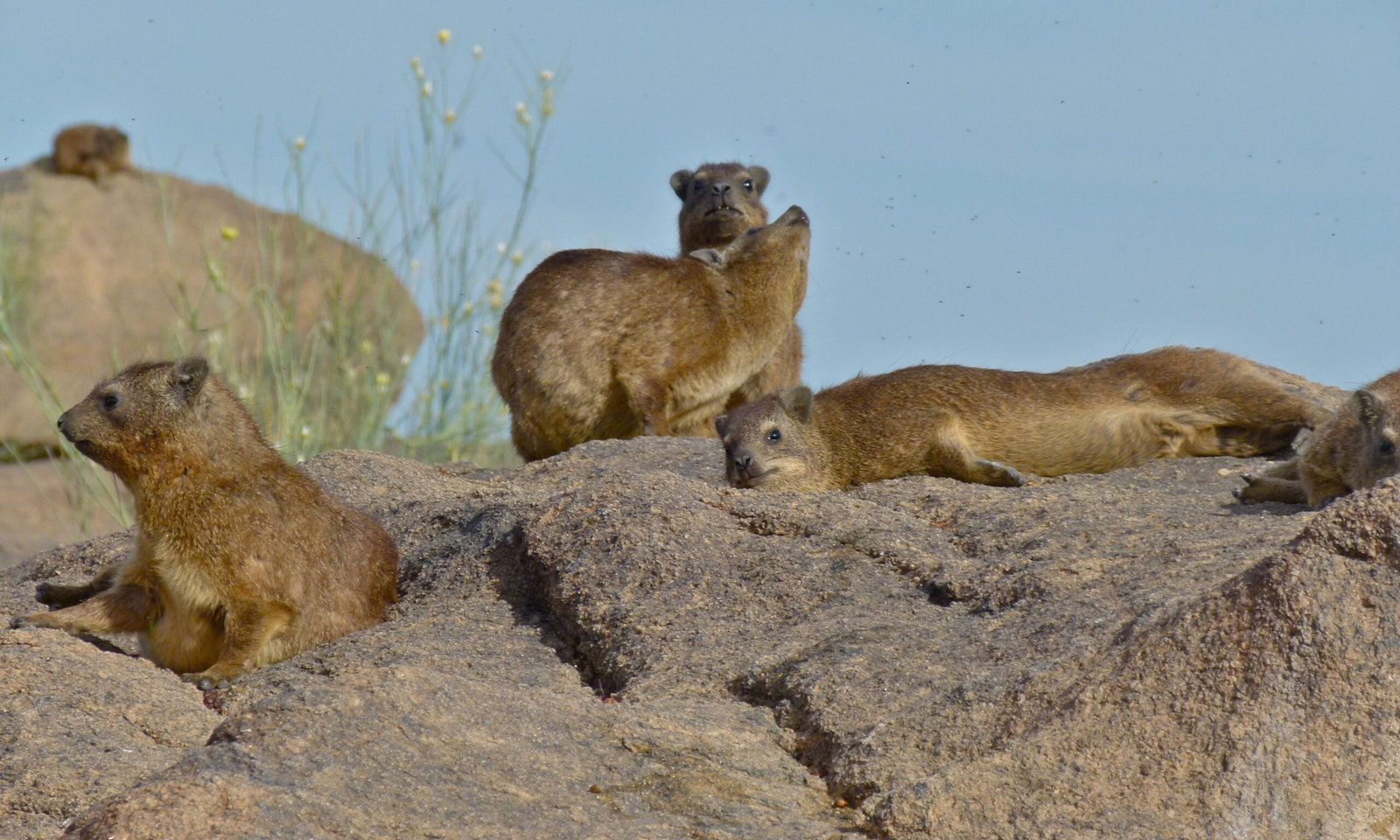
Perhaps the most surprising residents of Table Mountain are the rock dassies, cute rabbit-sized creatures that look like oversized guinea pigs but are actually the closest living relatives to elephants and manatees. These living fossils have been scrambling across Table Mountain’s rocky ledges for millions of years, essentially unchanged since their ancestors first made the mountain their home.
Dassies have evolved remarkable adaptations for their clifftop lifestyle, including specialized foot pads that work like natural suction cups, allowing them to scamper across seemingly impossible rock faces. Their social structure is surprisingly complex, with dominant males establishing territories and harems that would make a soap opera writer jealous. What’s most fascinating is how these small mammals have remained virtually identical to fossils found from 37 million years ago, making them living windows into ancient evolutionary history.
The Phantom Frogs of Hidden Streams
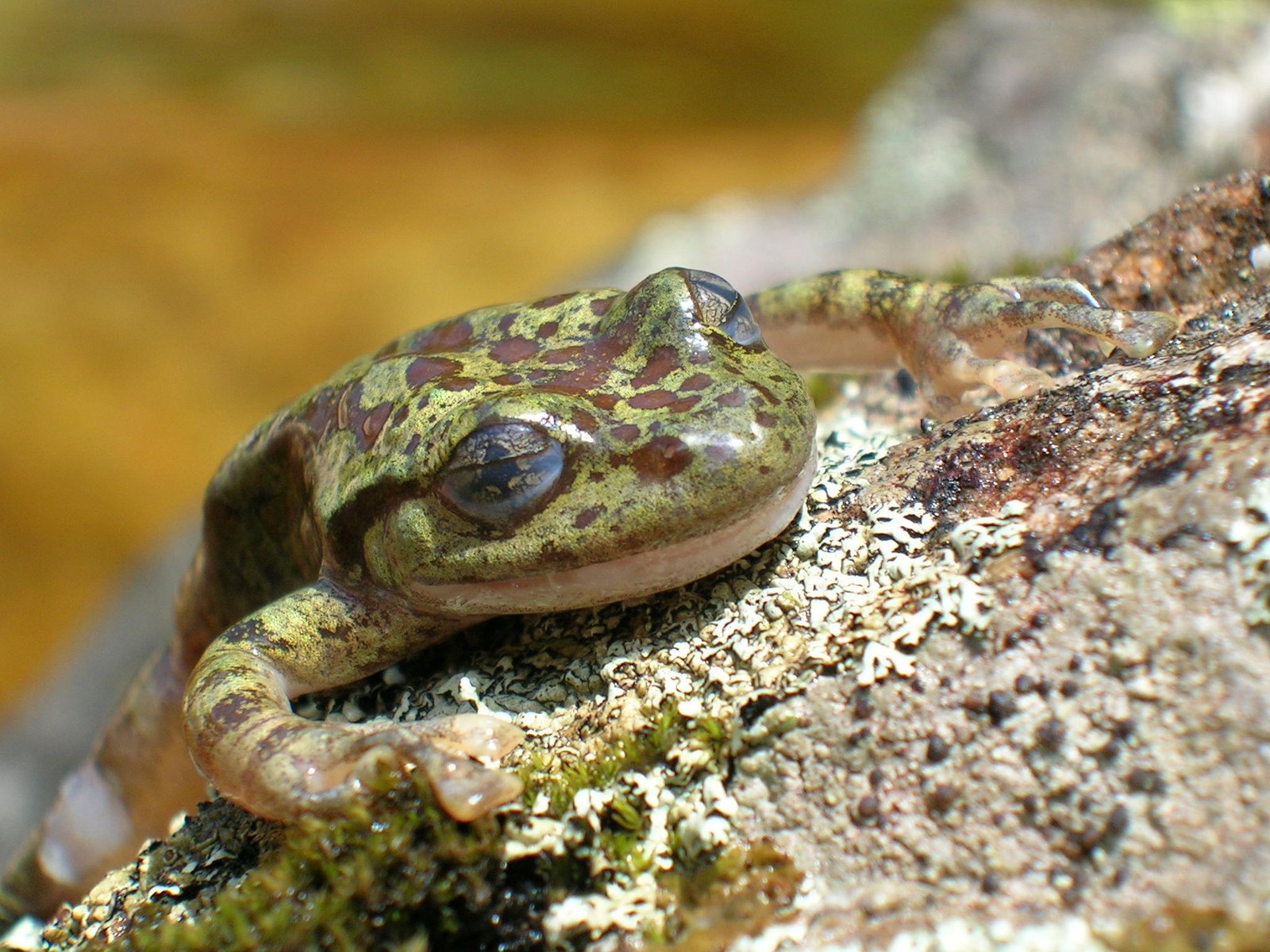
In the misty ravines and hidden streams of Table Mountain live some of the world’s most endangered amphibians, including species that weren’t even discovered by science until the late 20th century. The Table Mountain ghost frog, discovered only in 1931, represents one of the most ancient frog lineages on Earth, essentially a living fossil that has been croaking in these mountain streams for over 140 million years.
These phantom amphibians have evolved incredible specializations for their rocky, fast-flowing habitat. Their tadpoles have developed sucker-like mouthparts that allow them to cling to rocks in torrential mountain streams, while the adults have become master climbers, able to scale wet rock faces that would challenge experienced mountaineers. Unfortunately, their extreme specialization also makes them incredibly vulnerable – some species exist in populations of fewer than 2,000 individuals.
Chameleons That Rewrote the Rulebook

Table Mountain’s chameleons didn’t just adapt to their environment – they completely rewrote what it means to be a chameleon. While most of their African relatives are tree-dwelling creatures, the mountain’s endemic chameleon species have become ground-dwellers, developing shorter tails and more robust bodies for navigating rocky terrain.
The Cape dwarf chameleon, found only in the southwestern Cape including Table Mountain, has evolved the ability to change color not just for camouflage, but for thermoregulation – essentially using its skin as a biological solar panel to manage its body temperature in the mountain’s variable climate. These tiny dragons, rarely growing longer than 15 centimeters, represent millions of years of evolutionary experimentation in miniature.
The Secret World of Endemic Insects

Hidden among the fynbos vegetation is an entire universe of insects that exist nowhere else on Earth, many of which remain unnamed and unstudied by science. Table Mountain is home to an estimated 1,500 species of beetles alone, with new species still being discovered regularly by researchers who spend their careers crawling through the mountain’s diverse habitats.
Some of these insects have evolved such specific relationships with particular plant species that they can’t survive without each other. Certain beetles have become so specialized that they can only feed on one type of protea flower, while some moths have co-evolved with plants to become the only pollinators capable of reaching deep nectar stores. This intricate web of dependencies makes Table Mountain’s ecosystem incredibly rich but also frighteningly fragile.
Birds That Forgot How to Migrate
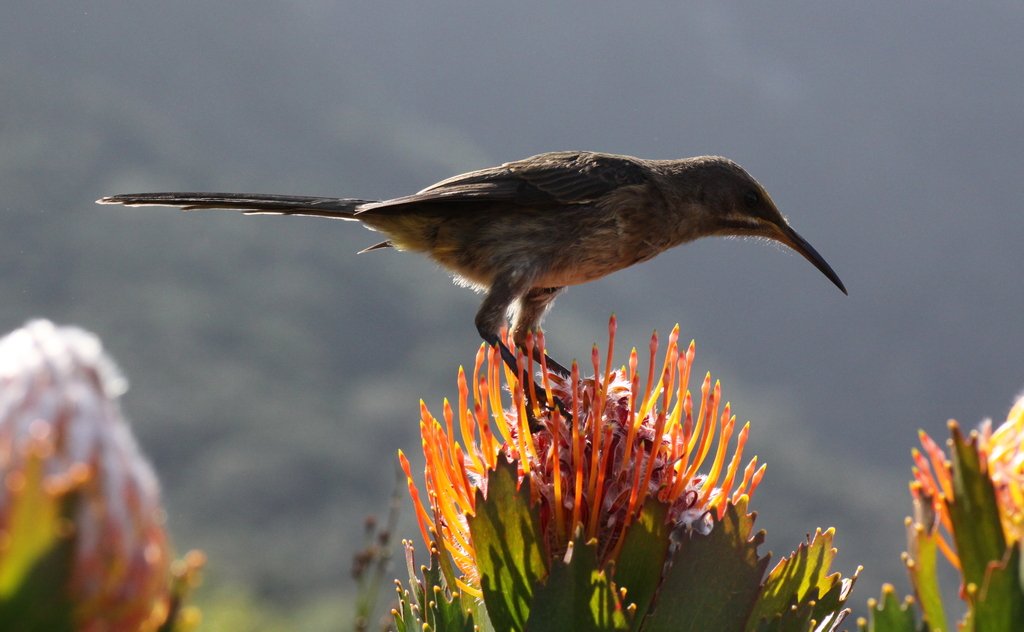
The mountain’s avian residents include several species that have essentially forgotten their ancestral migration patterns, becoming year-round residents of this sky island paradise. The Cape sugarbird, found only in the fynbos regions of the southwestern Cape, has evolved into a specialized nectar feeder with a ridiculously long tail that would be a hindrance anywhere else but works perfectly for navigating between protea flowers.
These birds have developed such specific feeding behaviors that they’ve become living extensions of the mountain’s plant ecosystem. The orange-breasted sunbird, another endemic species, has a curved bill that perfectly matches the shape of specific fynbos flowers, creating an evolutionary partnership that has been refined over millions of years. When these birds feed, they’re not just getting a meal – they’re participating in an ancient dance of co-evolution that keeps the entire mountain ecosystem functioning.
Reptiles Frozen in Evolutionary Time

Among the rocky crevices and sun-baked slopes of Table Mountain live reptiles that represent some of the oldest evolutionary lineages in Africa. The mountain’s endemic gecko species have been essentially unchanged for millions of years, perfectly adapted to their rocky habitat with specialized toe pads and cryptic coloration that makes them nearly invisible against the sandstone.
The Cape girdled lizard, with its armor-like scales and defensive behavior of wedging itself into rock cracks when threatened, represents a evolutionary strategy that has worked so well it hasn’t needed modification for millions of years. These living fossils provide scientists with glimpses into what southern African reptile communities looked like when dinosaurs still roamed the Earth.
The Underground Kingdom of Root Systems

Beneath Table Mountain’s visible splendor lies an even more remarkable world – a network of plant root systems that have been evolving in isolation for millions of years. Many fynbos plants have developed the most extensive root systems on Earth relative to their above-ground size, with some species having roots that extend more than 20 times deeper than the plant is tall.
These underground networks represent evolutionary adaptations to the mountain’s nutrient-poor soils and unpredictable rainfall patterns. Some plants have evolved specialized root structures called cluster roots that can extract phosphorus from rocks themselves, essentially eating the mountain to survive. This underground ecosystem supports fungi and microorganisms that exist nowhere else, creating an entire hidden biosphere beneath our feet.
Evolutionary Arms Races in Miniature

Table Mountain’s isolation has created numerous evolutionary arms races played out in miniature ecosystems. Predator and prey species have been locked in evolutionary battles for millions of years, each developing increasingly sophisticated adaptations to outwit the other. Some plants have evolved chemical defenses so specific that they only work against the particular insects that evolved alongside them.
The mountain’s trap-door spiders have evolved such perfect camouflage and hunting techniques that they’ve essentially become invisible assassins, perfectly adapted to their specific rocky habitats. Meanwhile, their prey species have developed equally impressive escape mechanisms, creating an ongoing evolutionary chess match that continues to this day.
Climate Refugees from Ancient Worlds

Many of Table Mountain’s most unusual species are actually climate refugees – survivors from ancient climatic periods who found sanctuary on the mountain when the rest of southern Africa became too hot, too cold, or too dry for their survival. The mountain’s varied microclimates provided refuge during ice ages, volcanic periods, and dramatic sea level changes.
Some plant species found on Table Mountain are more closely related to species found in Australia or South America than to plants growing just a few kilometers away at the mountain’s base. These species represent living links to the ancient supercontinent Gondwana, biological time capsules that have been preserved in the mountain’s unique environment for over 100 million years.
The DNA Time Machine

Modern genetic analysis has revealed that Table Mountain functions like a natural DNA time machine, preserving genetic lineages that disappeared everywhere else millions of years ago. Scientists studying the mountain’s endemic species regularly discover that they’re looking at evolutionary relationships that are far older than anyone previously imagined.
Some of the mountain’s plants contain genetic sequences that are so ancient they predate the evolution of flowers themselves. These living fossils carry within their DNA the stories of evolutionary experiments that failed everywhere else but somehow found success in the mountain’s unique environment. Each species represents a successful evolutionary solution to challenges that have long since disappeared from most of the planet.
Symbiotic Relationships That Defy Logic

Table Mountain’s isolation has fostered some of the most bizarre symbiotic relationships found anywhere on Earth. Certain plants have evolved to depend entirely on specific insects for reproduction, while those insects have become so specialized that they can’t survive without their plant partners. These relationships are so intricate that disturbing one species can cause the collapse of entire mini-ecosystems.
Some of the mountain’s most beautiful flowers can only be pollinated by a single species of beetle or fly, creating evolutionary partnerships that are both incredibly successful and terrifyingly fragile. When scientists study these relationships, they often discover that the partnerships are millions of years old, representing some of the longest-running biological collaborations on Earth.
The Mystery of Convergent Evolution

Perhaps most remarkably, Table Mountain has become a showcase for convergent evolution – the process by which unrelated species independently develop similar characteristics in response to similar environmental pressures. Multiple plant families on the mountain have independently evolved similar leaf shapes, root systems, and reproductive strategies, creating a natural experiment in evolutionary predictability.
Species that are only distantly related have developed nearly identical solutions to the challenges of surviving on the mountain’s harsh slopes. This convergent evolution suggests that there are optimal solutions to environmental challenges, and given enough time and isolation, life will discover these solutions regardless of its evolutionary starting point.
Modern Threats to Ancient Survivors

The same isolation that created Table Mountain’s unique evolutionary laboratory now makes its species incredibly vulnerable to modern threats. Climate change, invasive species, and human development pose existential challenges to creatures that have survived for millions of years by adapting to very specific local conditions.
Many of the mountain’s endemic species exist in such small populations and specialized habitats that even minor environmental changes could drive them to extinction within decades. Invasive plant species from Europe and Australia are already displacing native fynbos vegetation, while changing rainfall patterns threaten the delicate water balance that many species depend on for survival.
The Living Laboratory of Tomorrow

Despite the threats it faces, Table Mountain continues to function as one of the world’s most important natural laboratories for understanding evolution in action. Scientists are using the mountain’s unique species assemblages to study everything from climate adaptation to the genetic basis of speciation. New species are still being discovered regularly, with some estimates suggesting that we’ve identified less than half of the mountain’s total biodiversity.
The mountain’s role as an evolutionary laboratory extends beyond its current species to the processes that continue to shape life there. Researchers can observe evolution happening in real-time as species respond to environmental changes, providing unprecedented insights into how life adapts to challenges. These insights are becoming increasingly valuable as we try to understand how ecosystems might respond to global climate change.
Conservation Challenges for Evolutionary Treasures

Protecting Table Mountain’s evolutionary treasures requires a completely different approach from traditional conservation efforts. Because many species exist nowhere else and have highly specialized habitat requirements, losing even small patches of habitat can mean losing entire evolutionary lineages forever. Conservation efforts must focus not just on preserving species, but on maintaining the ecological processes that allowed evolution to create such remarkable diversity in the first place.
The challenge is made more complex by the fact that many of the mountain’s most important species are tiny, inconspicuous, or live underground, making them easy to overlook in conservation planning. Scientists are racing to catalog and understand these species before they disappear, but with limited resources and vast numbers of unstudied organisms, it’s a race against time that we may already be losing.
Table Mountain stands as one of evolution’s most successful experiments, a testament to what can happen when life is given time, isolation, and diverse challenges to overcome. The mountain’s “lost species” aren’t really lost at all – they’re evolutionary success stories that have been quietly thriving in their sky island paradise for millions of years. Each endemic species represents a unique solution to the challenges of survival, a biological patent that exists nowhere else in the universe.
The mountain’s evolutionary laboratory continues to operate today, creating new species and refining old ones in response to changing conditions. As we face unprecedented global environmental challenges, Table Mountain’s ancient survivors offer both inspiration and practical insights into the resilience and adaptability of life itself. The question isn’t whether these remarkable creatures deserve our protection – it’s whether we’re smart enough to learn from their millions of years of evolutionary wisdom before it’s too late.
What secrets do you think are still waiting to be discovered in the hidden corners of this ancient mountain?

